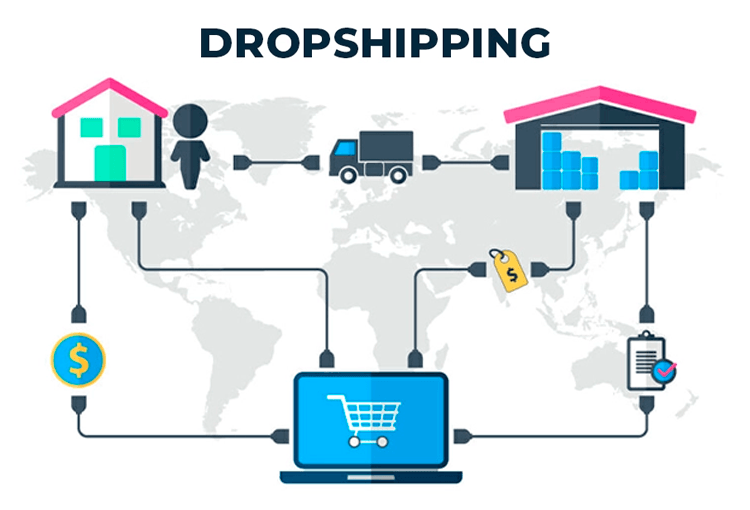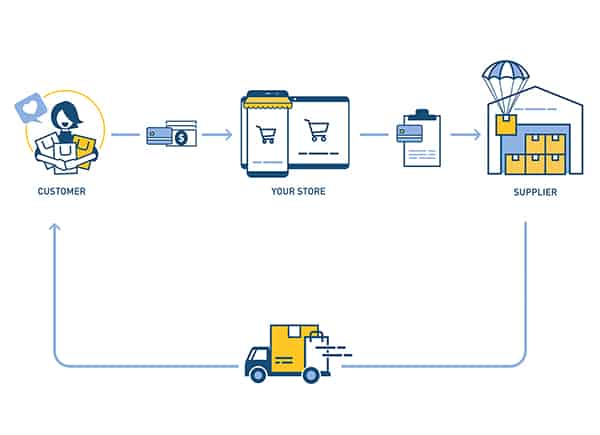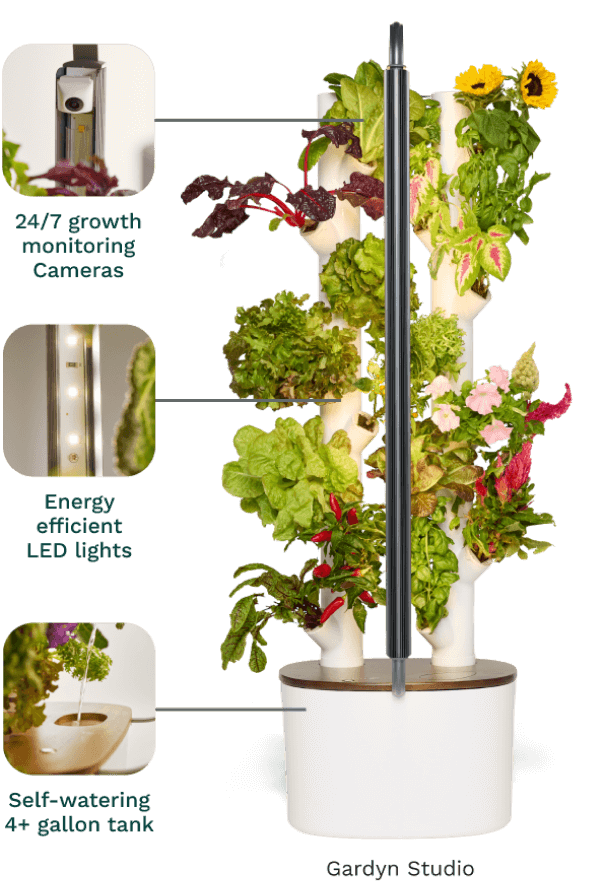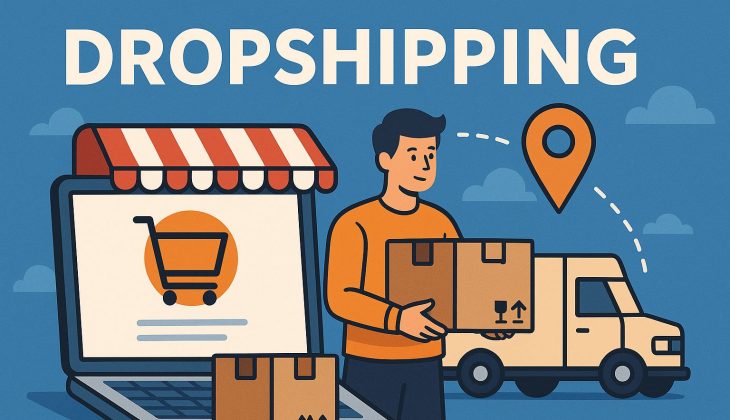Key Takeaways
- The global dropshipping market is projected to exceed $500 billion by 2026, with AI-powered personalization becoming essential for standing out in increasingly competitive niches.
- Sustainable products, AR shopping experiences, and social commerce integration will dominate successful dropshipping businesses in 2026.
- Eco-friendly home products and smart health monitoring devices represent high-growth niches with strong profit potential.
- Voice commerce optimization is predicted to account for over 30% of e-commerce transactions by 2026.
- The most successful dropshippers will embrace subscription models and automated customer service solutions to increase customer lifetime value.

“What is dropshipping e-commerce?” from tecnosoluciones.com and used with no modifications.
The dropshipping landscape is evolving at breakneck speed, with 2026 shaping up to be a pivotal year for e-commerce entrepreneurs. With the global market expected to surpass $500 billion, identifying the right trends early could mean the difference between thriving and merely surviving. Forward-thinking dropshippers are already positioning themselves to capitalize on emerging technologies and shifting consumer preferences that will define the industry in the coming years.
Dropshipping in 2026: The Game-Changing Trends You Can’t Ignore
The dropshipping model continues to evolve, with 2026 marking a significant shift toward more sophisticated, technology-driven approaches. Unlike the relatively straightforward dropshipping operations of previous years, success in 2026 will demand integration of advanced technologies, strategic niche selection, and superior customer experiences. The barriers to entry remain low, but the requirements for sustained success have increased dramatically as consumers expect more personalization, faster delivery, and seamless shopping experiences.
For those considering entering this field, it’s essential to learn how to start an e-commerce business effectively to mitigate these risks.
Oversaturated Markets and Rising Competition

“Business in an Oversaturated Market …” from www.smallbizdaily.com and used with no modifications.
The accessibility of dropshipping has created a double-edged sword. While it’s easier than ever to start a dropshipping business, standing out among thousands of competitors selling identical products has become increasingly difficult. Many traditional dropshipping niches will reach saturation points that make profitability nearly impossible for new entrants using conventional strategies.
Cookie-cutter stores with generic products sourced from the same suppliers will struggle to gain traction in an environment where consumers have endless options. The dropshippers who succeed will be those who either discover underserved micro-niches or add significant value through branding, education, or exceptional customer service.
Supply Chain Vulnerabilities

“Dropshipping Fulfillment | Global …” from www.nextsmartship.com and used with no modifications.
Global events between 2020 and 2025 have repeatedly exposed the fragility of international supply chains. Dropshippers who rely exclusively on single-source suppliers or regions will face substantial business continuity risks. Smart dropshippers are diversifying their supplier networks across multiple regions and investing in partnerships with manufacturers who have demonstrated resilience during disruptions.
Shipping delays, inventory inconsistencies, and quality control issues will continue to plague unprepared dropshippers, leading to poor customer experiences and damaged reputations. Building redundancy into your supply chain will be as important as your product selection strategy.
Evolving Consumer Expectations

“Adapting to Evolving Customer Expectations” from www.contactcenterpipeline.com and used with no modifications.
The bar for customer experience continues to rise, with 2026 consumers expecting near-instant delivery, seamless returns, and personalized shopping experiences as standard. Dropshippers clinging to outdated fulfillment models with 15-30 day shipping times will find it increasingly difficult to compete.
Additionally, transparency around product sourcing, sustainability practices, and corporate values will move from competitive advantages to basic requirements. Consumers will routinely investigate brands before purchasing, making it virtually impossible to succeed with dropshipping models that prioritize transactions over relationships.
7 Revolutionary Dropshipping Trends Reshaping the Industry
The dropshipping landscape of 2026 will be defined by several revolutionary trends that are already gaining momentum. These shifts represent both challenges and opportunities for entrepreneurs willing to adapt their business models accordingly. Understanding the impact of technological advancements, such as the metaverse, will be crucial for staying competitive in this evolving market.
1. Hyper-Personalization Through AI

“Hyper-Personalization at Scale: AI …” from aimagicx.com and used with no modifications.
Artificial intelligence will transform product recommendations from simplistic “customers also bought” suggestions to sophisticated personalization engines that consider hundreds of data points. By 2026, leading dropshipping stores will leverage AI to create dynamic shopping experiences that adapt in real-time to individual browsing behaviors, purchase history, and even external factors like local weather conditions or regional trends. This level of personalization will dramatically increase conversion rates while reducing marketing costs.
The most successful dropshippers will use AI not just for product recommendations but for personalized pricing strategies, customized landing pages, and individualized email marketing. Tools that once required enterprise-level budgets will become accessible to small dropshipping operations, leveling the playing field but raising the technological bar for success.
Discover some of the best AI tools for small businesses that can help you stay competitive.
2. Sustainable and Ethical Product Sourcing
“Building Sustainable Supply Chains …” from www.linkedin.com and used with no modifications.
Sustainability will shift from a marketing angle to a fundamental business requirement. Consumers will increasingly use browser extensions and apps that automatically evaluate a store’s environmental impact and ethical practices before checkout. Dropshippers who can verify their products’ sustainability credentials through blockchain or other transparent supply chain technologies will capture the growing segment of environmentally conscious consumers.
This trend will drive partnerships between dropshippers and suppliers who can provide detailed information about manufacturing processes, materials sourcing, and carbon footprints. Successful dropshippers will make these sustainability credentials central to their brand stories rather than afterthoughts.
3. Augmented Reality Shopping Experiences

“AR in retail: predictions on how AR …” from www.blippar.com and used with no modifications.
Augmented reality will revolutionize how consumers interact with products before purchase, drastically reducing return rates and increasing customer satisfaction. With time, AR technology will be integrated into dropshipping platforms, allowing customers to visualize products in their homes, try on clothing virtually, and interact with items in 3D space before buying. This technology will be particularly valuable for dropshippers in home décor, fashion, and cosmetics niches.
The dropshippers who implement AR capabilities early will gain significant advantages in conversion rates and customer loyalty.
4. Social Commerce Integration

“Social Commerce and How to Use It …” from umnico.com and used with no modifications.
The line between social media platforms and e-commerce will blur completely, with seamless shopping experiences embedded directly within social content. Successful dropshippers will leverage platforms that allow consumers to discover and purchase products without ever leaving their social media apps. This integration will significantly shorten the customer journey, reducing friction and abandoned carts.
Live shopping events—combining livestreaming, influencer marketing, and direct purchasing—will become mainstream across all major platforms. Dropshippers who master this format will create engaging shopping experiences that build community while driving sales. The immediacy and interactivity of live shopping will be particularly effective for product demonstrations and limited-time offers.
5. Voice Commerce Optimization

“Voice Commerce – The Future Of Online …” from blog.fordeercommerce.io and used with no modifications.
As smart speakers and voice assistants become ubiquitous in homes worldwide, voice commerce will account for a significant portion of online sales. Forward-thinking dropshippers are already optimizing their product listings for voice search and creating voice-specific shopping experiences. This trend will particularly benefit dropshippers selling consumable products that lend themselves to routine reordering.
Voice commerce presents unique challenges for product discovery, as consumers can’t visually browse options. Successful dropshippers will adapt by focusing on building brand recognition so customers specifically ask for their products by name. They’ll also need to carefully structure product information to answer common spoken queries naturally.
6. Subscription-Based Dropshipping Models

“Dropshipping Subscription Box Business …” from www.youtube.com and used with no modifications.
The subscription economy will intersect with dropshipping in powerful ways, offering entrepreneurs more predictable revenue streams and higher customer lifetime values. Savvy dropshippers will transform one-time purchases into recurring subscription boxes across various niches, from specialty foods to personalized fashion selections. This model rewards customer loyalty while creating reliable monthly income.
The most innovative dropshippers will use AI to personalize subscription contents based on individual preferences, usage patterns, and feedback. This level of customization will justify premium pricing while reducing cancellation rates.
7. Automated Customer Service Solutions

“Customer Service Automation: How to Do …” from helpjuice.com and used with no modifications.
Advanced AI chatbots and virtual assistants will handle customer service interactions for successful dropshipping operations. These systems will go beyond simple FAQ responses to provide personalized assistance throughout the customer journey. The technology will be sophisticated enough to recognize customer emotions, adapt communication styles accordingly, and proactively address potential issues before they escalate.
Smart dropshippers will leverage these tools to provide 24/7 multilingual support without scaling their human teams proportionally to sales growth. This capability will be particularly valuable for dropshippers targeting global markets with customers across multiple time zones and language preferences.
Top 5 High-Profit Dropshipping Niches for 2026
While identifying profitable niches requires ongoing market research, our analysis indicates several categories poised for exceptional growth in 2026. These niches combine strong consumer demand with favorable market conditions and relatively manageable competition levels.
1. Eco-Friendly Home Products

“Eco-Friendly and Sustainable Products …” from www.druidebio.fr and used with no modifications.
The sustainable home products market is projected to reach $54 billion by 2026, driven by growing environmental awareness and increasingly strict regulations on single-use plastics. Products like biodegradable cleaning supplies, water conservation devices, and energy-efficient home tools will experience surging demand. Dropshippers who can verify sustainability claims and educate consumers about environmental benefits will capture premium pricing in this expanding market.
Particularly promising sub-niches include plastic-free kitchen products, water filtration systems, and eco-friendly pest control solutions. The beauty of this niche lies in combining genuine environmental benefits with practical everyday utility, making repeat purchases common and brand loyalty stronger than in many other categories.
2. Smart Health Monitoring Devices

“Smart Devices to Detect Health …” from link.springer.com and used with no modifications.
The convergence of health consciousness, aging populations, and technological advancement will drive massive growth in the smart health monitoring space. Devices that track specific health metrics beyond basic fitness data—like sleep quality, hydration levels, and stress indicators—will see particularly strong demand. Dropshippers who can provide valuable context and education around these devices will differentiate themselves in an increasingly crowded market.
The regulatory environment for these products continues to evolve, creating opportunities for dropshippers who stay informed about compliance requirements across different markets. Products that connect to healthcare providers’ systems or integrate with popular health apps will command premium prices and foster strong customer loyalty.
3. Personalized Wellness and Self-Care

“15 Wellness Products We Tried and LOVE …” from www.bubblymoments.com and used with no modifications.
The personalized wellness revolution will reach new heights by 2026, with consumers increasingly seeking customized solutions rather than one-size-fits-all products. Dropshippers offering personalized supplement regimens, customized skincare formulations, and tailored self-care ritual kits will capture significant market share. The key success factor will be developing systems that effectively gather individual preferences and needs while making evidence-based recommendations.
This niche benefits from high margins, strong brand loyalty potential, and natural opportunities for subscription models. Successful dropshippers will combine quality products with digital tools that help customers track their progress and optimize their wellness routines over time.
4. Tech-Enhanced Fitness Equipment

“Health and Fitness Tech …” from www.pcmag.com and used with no modifications.
The home fitness market will continue its post-pandemic evolution with increasing demand for space-efficient, technology-integrated equipment. Smart resistance bands, AI-powered yoga mats, and connected strength training tools will replace bulky traditional equipment. Dropshippers who curate effective home fitness ecosystems rather than simply selling individual products will create valuable customer relationships and opportunities for multiple purchases.
If you’re interested in starting your own dropshipping business, here’s a guide to starting an e-commerce business that can help you get started.
This niche offers opportunities to develop proprietary product bundles and complementary digital content that enhances the physical products’ value. The combination of recurring hardware sales and potential subscription revenue makes this a particularly attractive category for 2026.
5. Sustainable Fashion and Accessories

“Sustainable Terminology in Fashion …” from www.considerate-consumer.com and used with no modifications.
Sustainable fashion will move from niche to mainstream, with consumers increasingly rejecting fast fashion in favor of ethically-produced, durable clothing. Dropshippers who can verify their products’ sustainability credentials—from material sourcing to manufacturing conditions and carbon footprint—will capture this growing market. Categories like recycled-material activewear, ethically-produced basics, and upcycled accessories show particularly strong growth potential.
The most successful dropshippers in this space will tell compelling stories about their products’ origins and impact, creating emotional connections that justify premium pricing. They’ll also leverage technology to help customers find their perfect fit, dramatically reducing costly returns that plague the fashion category.
Each of these niches offers strong growth potential, but the most successful dropshippers will further specialize to identify micro-niches where they can establish true authority. Market research indicates that highly-focused stores consistently outperform general stores, even within specific categories like sustainable fashion or smart health devices.
- Look for niches with year-over-year search volume growth of at least 20%
- Target categories with average order values above $50 to maximize profitability
- Prioritize products with margin potential of 40% or higher after all costs
- Identify niches where you can add unique value through content or curation
- Consider seasonal demand patterns and develop strategies for off-peak periods
Emerging Micro-Niches with Massive Potential
Beyond the broader niche categories, several micro-niches show exceptional promise for 2026. These specialized segments often fly under the radar of larger competitors but demonstrate strong growth signals and passionate customer bases. Entrepreneurs who position themselves as specialists in these areas can build profitable dropshipping operations with less direct competition.
Plant-Based Pet Products

“Plant-Based Dog Food: A Soothing …” from petcubes.com and used with no modifications.
The intersection of pet ownership and plant-based lifestyles will create significant opportunities by 2026. Products like vegan pet treats, plant-based supplements, and eco-friendly toys made from sustainable materials will experience surging demand. This micro-niche benefits from passionate customers willing to pay premium prices for products that align with their values and their pets’ wellbeing.
Work-From-Anywhere Productivity Tools

“Best Remote Work Tools and Software | Rock” from www.rock.so and used with no modifications.
The continued evolution of remote and hybrid work will drive demand for specialized products that enhance productivity in non-traditional work environments. Portable dual monitors, noise-cancelling devices for public spaces, and ergonomic equipment designed for travel will see substantial growth. Dropshippers who understand the specific pain points of digital nomads and remote workers can build highly targeted stores with strong conversion rates.
Products that solve multiple problems simultaneously—like backpacks with built-in power banks and ergonomic features—will command especially strong margins in this category. Successful dropshippers will focus on curation and education, helping customers create optimal mobile workspaces rather than simply selling individual gadgets.
Virtual Reality Accessories

“Oculus Quest 2 Silicone Case …” from www.aliexpress.com and used with no modifications.
As VR headsets reach mainstream adoption by 2026, the market for accessories and enhancements will explode. Products like custom facial interfaces, enhanced audio solutions, and specialized controllers for specific applications will see tremendous growth. This micro-niche benefits from enthusiastic early adopters willing to invest heavily in optimizing their VR experiences.
Indoor Gardening Technology

“Gardyn: Hydroponic System – Growing …” from mygardyn.com and used with no modifications.
The convergence of food security concerns, wellness trends, and smart home technology will drive substantial growth in indoor gardening solutions. Products like app-controlled growing systems, specialized LED lighting, and subscription-based seed delivery services will gain significant traction. This category offers natural opportunities for educational content that builds authority and drives organic traffic.
The most successful dropshippers in this space will create end-to-end solutions that make indoor gardening accessible to beginners while offering advanced options for enthusiasts. The combination of hardware sales and consumable supplies creates excellent lifetime value potential.
How to Validate Your Dropshipping Niche in 2026
Identifying promising niches is only the first step—thorough validation is essential before committing resources to a dropshipping venture. By 2026, the tools and methodologies for niche validation will become more sophisticated but also more accessible to entrepreneurs without technical expertise. A systematic approach to validation can dramatically reduce risk and increase your odds of success.
Market Demand Analysis Tools
Advanced market intelligence platforms will provide dropshippers with unprecedented insights into consumer demand patterns by 2026. Beyond basic keyword research, these tools will analyze social media conversations, monitor emerging trends across global markets, and identify product categories with accelerating growth curves. Successful dropshippers will use these platforms to spot opportunities months before they become obvious to the broader market.
The most valuable tools will combine quantitative data with qualitative insights, helping entrepreneurs understand not just what consumers are buying but why they’re making those purchases. This deeper understanding enables more effective marketing and product positioning in increasingly competitive niches.
Marketing Strategies That Will Dominate in 2026
The dropshipping marketing landscape will undergo significant transformation by 2026, with strategies becoming more immersive, personalized, and value-driven than ever before. Traditional tactics like generic Facebook ads and basic email campaigns will deliver diminishing returns as consumers grow increasingly sophisticated. Successful dropshippers will adopt integrated marketing approaches that create seamless experiences across multiple touchpoints while delivering genuine value beyond promotional messaging.
AI-Powered Customer Targeting
“AI-Powered Precision: Marketing Tools …” from www.linkedin.com and used with no modifications.
By 2026, AI-driven marketing platforms will enable unprecedented targeting precision, analyzing thousands of data points to identify ideal customers with specific pain points your products solve. These systems will continuously learn from customer interactions, automatically optimizing ad creatives, copy variations, and bidding strategies in real-time. The most successful dropshippers will leverage predictive analytics to identify potential customers before they’ve even recognized their own needs, positioning products as solutions at precisely the right moment in the consumer journey.
Immersive Content Marketing

“Immersive Marketing: The Blend of …” from buildingbrandsmarketing.com and used with no modifications.
Content marketing will evolve from basic blogs and product videos to fully immersive experiences that blend entertainment, education, and shopping. Interactive product demonstrations using augmented reality will let customers experience products virtually before purchasing, dramatically reducing uncertainty and return rates. This shift toward experiential content will be particularly effective for complex or high-consideration products where traditional product images fall short.
Shoppable livestreams will become mainstream across all major social platforms, combining the authenticity of live video with the convenience of instant purchasing. Successful dropshippers will develop regular programming that attracts consistent viewership rather than one-off promotional events. The most effective streams will balance entertainment value with product integration, creating engaging experiences that consumers actively seek out rather than avoid.
User-generated content will gain even greater importance as consumers increasingly distrust traditional advertising. Smart dropshippers will build communities around their products and actively encourage customers to share their experiences through incentive programs and interactive challenges. The brands that make customers the heroes of their stories will outperform those that position themselves as the heroes.
For more strategies, consider exploring affiliate marketing tips to enhance your marketing efforts.
Micro-Influencer Collaborations

“Nano And Micro Influencers – Midas PR” from midas-pr.com and used with no modifications.
“By 2026, micro-influencer marketing will deliver 4x higher engagement rates and 2x better conversion rates compared to celebrity endorsements, with 78% of consumers trusting recommendations from smaller, more authentic influencers over traditional celebrities.”
The influencer marketing landscape will continue its evolution toward authenticity and specialization, with micro-influencers (those with 5,000-50,000 followers) delivering superior results compared to macro-influencers with massive but less engaged audiences. Successful dropshippers will build networks of these niche experts who can speak authentically about their products to highly targeted audiences. These partnerships will go beyond transactional sponsorships to include product development input, exclusive co-branded lines, and long-term ambassador relationships.
Learn more about affiliate marketing tips and strategies to enhance your collaboration efforts.
AI-powered influencer matching platforms will streamline the process of finding perfect partners based on audience demographics, engagement metrics, and brand alignment scores. These tools will also provide sophisticated performance tracking that goes beyond basic engagement metrics to measure actual conversion impact and customer lifetime value generated through influencer channels. The most sophisticated dropshippers will use these insights to continuously refine their influencer strategies.
Rather than treating influencer marketing as a separate channel, leading dropshippers will integrate influencer content throughout the customer journey. From discovery through consideration and post-purchase support, authentic recommendations from trusted voices will guide consumers through each stage of the relationship with your brand. This integrated approach will maximize the return on influencer investments while creating more cohesive brand experiences.
Sustainability Storytelling

“communicate your sustainability story …” from trellis.net and used with no modifications.
Environmental and social impact will move from peripheral concerns to central positioning for successful brands. Rather than making vague claims about sustainability, dropshippers will need to tell specific, verifiable stories about their products’ origins, manufacturing processes, and environmental footprints. Blockchain-verified supply chains will enable customers to trace products from source to delivery, creating unprecedented transparency. The most successful dropshippers will transform sustainability from a checkbox feature to compelling narratives that create emotional connections with increasingly conscious consumers.
The Technology Stack Every 2026 Dropshipper Needs
The technological requirements for dropshipping success will increase substantially by 2026, with integrated platforms replacing the patchwork solutions many entrepreneurs currently use. This evolution will actually benefit smaller operators who can adopt comprehensive solutions without the legacy system constraints that hamper larger competitors. Forward-thinking dropshippers are already investing in future-proof technology stacks that will scale with their businesses while automating increasingly complex operations.
Rather than selecting individual tools for specific functions, successful dropshippers will prioritize platforms that offer seamless integration across the entire business ecosystem. This integrated approach will eliminate data silos, reduce manual processes, and provide comprehensive analytics for more informed decision-making. The initial investment may be higher, but the operational efficiency gains will create significant competitive advantages over time.
Next-Gen Automation Platforms
By 2026, automation capabilities will extend far beyond simple product uploads and order routing to encompass nearly every aspect of dropshipping operations. Advanced platforms will use machine learning to automatically optimize product descriptions for different marketplaces, dynamically adjust pricing based on competition and demand signals, and proactively identify potential supply chain disruptions before they impact fulfillment. These systems will continuously learn from operational data, becoming more effective over time without requiring constant human oversight.
The most sophisticated automation platforms will incorporate predictive capabilities that transform reactive dropshipping models into proactive operations. Instead of responding to orders after they’re placed, these systems will anticipate demand patterns and automatically position inventory closer to likely customers, dramatically reducing delivery times. They’ll also identify potential problems—like inventory shortages or shipping delays—and implement contingency plans before customers are affected.
Inventory Forecasting AI
- Real-time supplier inventory visibility across distributed networks
- Demand prediction based on historical data, market trends, and external factors
- Automatic reallocation of orders to optimal fulfillment locations
- Early warning systems for potential stockouts or fulfillment delays
- Dynamic pricing recommendations based on inventory availability
Inventory management will become significantly more sophisticated by 2026, with AI systems that can predict demand fluctuations with remarkable accuracy. These platforms will analyze historical sales data alongside external factors like weather patterns, social media trends, and even macroeconomic indicators to forecast demand across different product categories and regions. The most advanced systems will automatically adjust inventory strategies based on these predictions, ensuring optimal product availability without excessive reliance on any single supplier.
For dropshippers, who traditionally don’t hold inventory, these tools will transform relationships with suppliers by enabling more accurate forecasting and planning. Rather than simply routing orders as they come in, dropshippers will provide suppliers with detailed projections that help them prepare for demand surges. This collaborative approach will secure preferential treatment from suppliers while reducing fulfillment delays during high-demand periods.
The combination of predictive analytics and real-time inventory visibility will also enable more sophisticated pricing strategies. Dynamic pricing algorithms will automatically adjust product pricing based on availability, competitor pricing, and current demand levels. These systems will identify the optimal balance between maximizing margin and maintaining competitive positioning, resulting in significantly higher profitability without requiring constant manual monitoring.
Customer Journey Analytics Tools
Understanding the complete customer journey will become essential for dropshipping success by 2026, with advanced analytics platforms providing unprecedented visibility into every touchpoint from discovery to post-purchase engagement. These tools will go beyond basic conversion tracking to reveal the complex pathways customers take before making purchase decisions. Dropshippers will use these insights to identify friction points, optimize high-impact touchpoints, and create more effective cross-channel experiences that guide customers naturally toward purchase decisions.
- Attribution modeling that accurately values each marketing touchpoint
- Sentiment analysis across review platforms and social media channels
- Behavior prediction algorithms that identify potential churn risks
- Personalization engines that dynamically adjust content based on journey stage
- Lifetime value forecasting for more strategic customer acquisition investments
The most valuable journey analytics platforms will incorporate voice-of-customer data from multiple sources, including reviews, support interactions, and social media mentions. By analyzing this qualitative feedback alongside behavioral data, dropshippers will gain deeper understanding of customer motivations and pain points. These insights will inform everything from product selection and positioning to marketing messages and post-purchase support strategies.
Advanced journey mapping will also reveal opportunities for strategic interventions at critical decision points. AI systems will identify patterns that indicate purchase hesitation or abandonment risk, triggering personalized outreach or incentives precisely when they’re most likely to influence outcomes. This capability will significantly improve conversion rates while reducing customer acquisition costs through more efficient intervention strategies.
Perhaps most importantly, these analytics platforms will help dropshippers shift focus from transaction-based metrics to relationship-based measures of success. By tracking customer lifetime value, repeat purchase rates, and advocacy behaviors, businesses will make better decisions about where to invest their limited resources for maximum long-term impact. This perspective shift will be particularly valuable in competitive niches where customer acquisition costs continue to rise.
Turn These Trends Into Your Competitive Advantage
“The greatest opportunity in dropshipping for 2026 isn’t finding untapped product categories—it’s applying next-generation approaches to categories where traditional dropshippers continue using outdated playbooks. The businesses that combine niche expertise with technological sophistication will create insurmountable advantages over competitors who fail to evolve.”
The dropshipping landscape of 2026 will reward entrepreneurs who approach the business model with strategic sophistication rather than get-rich-quick expectations. Success will require thoughtful niche selection, technological investment, and commitment to creating genuine value for customers. While these requirements may seem daunting, they actually create significant opportunities for dedicated entrepreneurs willing to build businesses with stronger foundations than the typical dropshipping ventures of previous years.
Start by conducting thorough market research to identify niches where you can establish genuine authority and differentiation. Look beyond obvious product opportunities to understand the underlying customer needs and pain points these products address. The most successful dropshippers will position themselves as solutions to specific problems rather than simply product vendors. This problem-solving orientation creates natural opportunities for premium positioning and higher margins.
Invest early in building technological capabilities that will scale with your business. While sophisticated AI tools and automation platforms represent significant investments, they create operational efficiencies that dramatically reduce costs over time. More importantly, they enable personalized customer experiences that drive higher conversion rates, larger average order values, and stronger customer loyalty. View technology as a strategic investment rather than an operational expense.
Frequently Asked Questions
As the dropshipping landscape evolves toward 2026, entrepreneurs naturally have questions about how these changes will affect their businesses. Here are answers to the most common questions we receive about the future of dropshipping, based on current market research and emerging trends. Remember that while these projections represent our best analysis of future conditions, the most successful dropshippers will continuously adapt their strategies as the market evolves.
Staying informed about industry developments and maintaining flexibility in your business model will be essential for navigating the rapidly changing e-commerce ecosystem. Consider joining dropshipping communities and following industry publications to ensure you’re aware of emerging trends before they become mainstream knowledge.
For those interested in starting an online business, here’s a guide on how to start an e-commerce business.
How will AI impact dropshipping profit margins in 2026?
AI will have dual effects on dropshipping profit margins in 2026. On one hand, automation will significantly reduce operational costs by streamlining product research, customer service, marketing optimization, and order processing. Sophisticated AI tools will enable even small dropshipping operations to function with efficiency previously possible only for large enterprises. On the other hand, these same tools will become widely available, potentially increasing competition and putting pressure on margins in less differentiated niches. The net effect will depend largely on how strategically dropshippers implement AI capabilities.
The dropshippers who achieve the highest profit margins will use AI not just for operational efficiency but for creating unique customer experiences that competitors can’t easily replicate. This might include hyper-personalized product bundles, customized unboxing experiences, or predictive reordering systems that anticipate customer needs before they even recognize them themselves. These differential advantages will support premium pricing even in competitive categories.
Which countries will be the best sourcing locations for dropshippers in 2026?
By 2026, sourcing diversification will become standard practice among successful dropshippers, with multi-country supplier networks replacing single-source dependencies. While China will remain important, countries like Vietnam, India, Mexico, and Poland will gain significant market share in dropshipping supply chains. This shift will be driven by a combination of factors including rising labor costs in China, geopolitical considerations, and growing consumer preference for shorter supply chains with reduced carbon footprints. Smart dropshippers will develop relationships with suppliers across multiple regions to ensure business continuity and faster shipping options for different target markets.
Beyond geographical diversification, successful dropshippers will also prioritize suppliers with advanced technological capabilities. The ability to integrate directly with your systems for real-time inventory updates, automated order processing, and quality control tracking will become as important as unit pricing in supplier selection decisions. Suppliers offering value-added services like custom packaging, product customization, and direct brand application will command premium prices but deliver significantly better customer experiences.
For more insights, explore these best dropshipping products that can enhance your business strategy.
Is dropshipping still profitable in 2026 compared to other e-commerce models?
Dropshipping will remain profitable in 2026, but with greater stratification between sophisticated operators and basic resellers. The traditional model of simply listing generic products from overseas suppliers with minimal added value will yield increasingly thin margins due to fierce competition and rising customer acquisition costs. However, evolved dropshipping models that incorporate private labeling, custom bundling, exclusive supplier relationships, and value-added services will continue to generate healthy profits. The businesses that combine dropshipping’s capital efficiency with brand-building strategies will achieve profitability comparable to or exceeding traditional inventory-holding models while maintaining significantly lower risk profiles.
What shipping innovations will change dropshipping in 2026?
By 2026, distributed fulfillment networks will transform dropshipping logistics, with suppliers maintaining inventory in multiple strategic locations to enable 1-3 day delivery to major markets. Drone delivery and autonomous vehicles will handle last-mile fulfillment in many urban areas, reducing costs while improving delivery speed. Perhaps most significantly, predictive shipping—where AI systems anticipate orders and position products closer to likely customers before purchases occur—will become mainstream among advanced dropshippers. These innovations will effectively eliminate the historical shipping speed disadvantage of dropshipping compared to traditional e-commerce, allowing entrepreneurs to compete directly with marketplace giants on delivery experience.
How much startup capital will I need for a successful dropshipping business in 2026?
While dropshipping will remain one of the most capital-efficient e-commerce models in 2026, realistic startup requirements will increase from the often-cited figures of previous years. Successful launches will typically require $5,000-$15,000 in initial investment, covering advanced store development, premium theme customization, sophisticated marketing automation tools, and sufficient advertising budget to generate meaningful data for optimization. This represents a significant increase from the under-$1,000 startup costs often promoted in dropshipping courses, but reflects the greater sophistication required to compete effectively. Entrepreneurs should plan for 3-6 months of operating expenses before achieving consistent profitability, with faster timelines possible but increasingly rare in competitive niches.
Despite these higher barriers to entry, dropshipping will continue to offer compelling advantages over inventory-holding business models that might require $50,000+ to launch with similar product selection. The capital efficiency of dropshipping allows entrepreneurs to test multiple niches and product offerings with relatively low financial risk, making it an ideal model for market validation before potential expansion into private labeling or inventory holding as the business matures.
The future of dropshipping belongs to entrepreneurs who approach it as a legitimate business model requiring real expertise, strategic thinking, and continuous adaptation. By embracing the trends and technologies that will define the industry in 2026, you’ll position yourself for success while many competitors struggle to evolve beyond outdated approaches. The window of opportunity is open now for forward-thinking entrepreneurs willing to build tomorrow’s dropshipping businesses today.




Join the Conversation